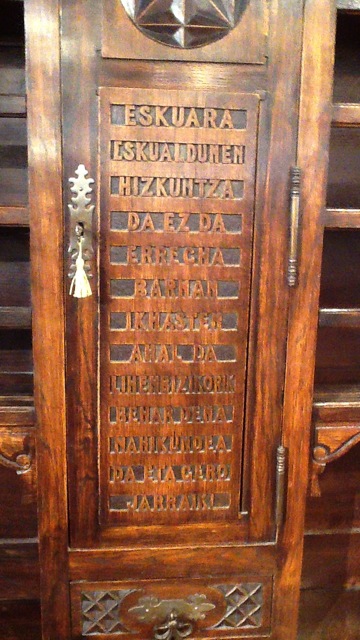
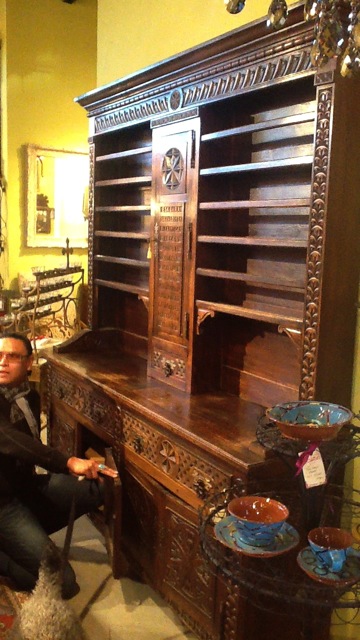 The last few weekends, my family and I have been visiting consignment galleries, hoping to put an item up for sale. Usually, we simply hear that they aren’t interested and then we end up wandering the gallery for an hour, looking at all of the memories people are hoping to get a little bit of cash for, most of which don’t really pique our interest. Once in a while, we see something that would look pretty cool in our house, but doesn’t quite fit either our decor or our budget.
The last few weekends, my family and I have been visiting consignment galleries, hoping to put an item up for sale. Usually, we simply hear that they aren’t interested and then we end up wandering the gallery for an hour, looking at all of the memories people are hoping to get a little bit of cash for, most of which don’t really pique our interest. Once in a while, we see something that would look pretty cool in our house, but doesn’t quite fit either our decor or our budget.
Today, however, we stumbled, almost quite literally, on the most amazing piece, not only because of its beauty, but also because the piece was adorned with Euskara.
We were wandering through the gallery, passing various pieces of furniture, most of which didn’t get much of a second glance from us. However, this ornate sideboard did catch my eye, especially when I noticed some writing on the central cabinet and rosettas that were familiar. It took me a second to register what I was seeing. A sideboard, here in Santa Fe, with a phrase in Euskara as the focus? Carved on the central cabinet of the sideboard was the following phrase:
Eskuara eskualdunen hizkuntza da ez da errecha barnan ikhasten ahal da lihenbizikoria behar dena nahikundea da eta gero jarraiki
The piece is also adorned with rosettas similar to what I’ve seen in other pieces in the Basque Country and in drawings. It has shelves for displaying plates and platters, cabinets underneath, and, as I mentioned, that central cabinet with the Euskara on the front, and a lock.
Amazingly, the gallery had only recently received it, only about a week ago, from an estate in Santa Fe.
If anyone might have any answers as to where this sideboard might have been made and when, I’d be greatly interested. Anyone know anything about this?
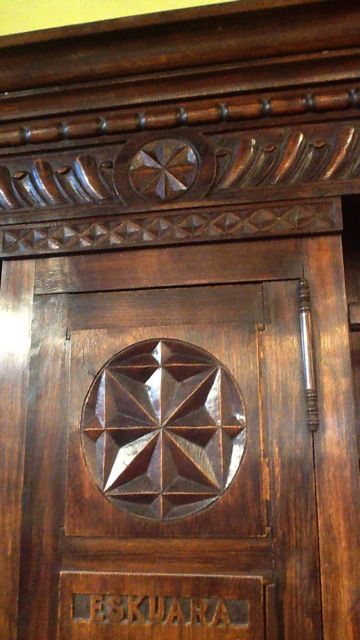
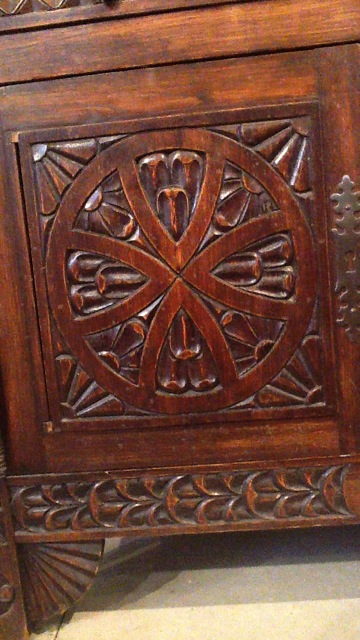
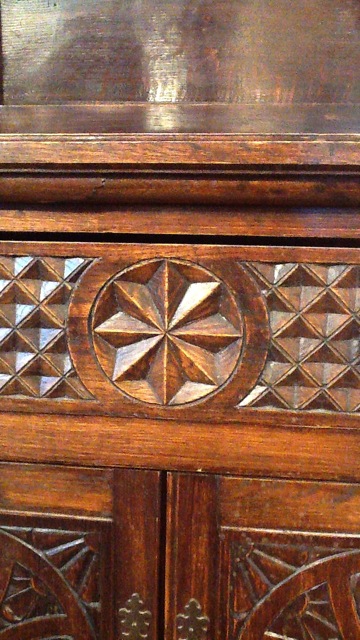 While it is a very cool piece, more than wanting it I’m very intrigued by it. Where did it come from? How old might it be? Why did someone in Santa Fe have it? Were they Basque, desiring something from their homeland in their home, or had they simply traveled to the Basque Country, fallen in love with the place, and purchased an admittedly extravagant souvenir? What does the Euskara translate into? I know it has to do with the language and learning, but the full meaning escapes me. It would be great to know more about the history of both the piece and the person who owned it.
While it is a very cool piece, more than wanting it I’m very intrigued by it. Where did it come from? How old might it be? Why did someone in Santa Fe have it? Were they Basque, desiring something from their homeland in their home, or had they simply traveled to the Basque Country, fallen in love with the place, and purchased an admittedly extravagant souvenir? What does the Euskara translate into? I know it has to do with the language and learning, but the full meaning escapes me. It would be great to know more about the history of both the piece and the person who owned it.
The consignment gallery that has this remarkable, at least for Santa Fe, piece is Recollections.
Discover more from Buber's Basque Page
Subscribe to get the latest posts sent to your email.


“Basque is the language of Basque people, it is not easy but one may learn it, first of all you need the will and then to keep on”. French Basque Country dialecte.
Eskerrik asko Montxo! I really appreciate it. Do you know which dialect it is, from where in Iparraldea?
Looks like a beautiful piece that would look great in a Basque club. Or perhaps the Basque Museum! You should contact the museum about it. It looks too big to have been in someone’s house — perhaps from a library? And how did it get to the U.S.? Curious!
Kaixo Nancy! I agree. The gallery said it was from an estate, but I didn’t get any more details. It’s possible history is almost as interesting, maybe more so, than the piece itself!
There is a photo of a similar piece on a web site called “ostau deu moble bearnes” or search under “entre-les-luys” Entre les luys is a region in Bearn, Pyrenees. The star with 8 points, is typical, or as I understand, of Entre les Luys. and the little squares like on both side of the stars is the Bee Hives style. Even though the piece in Santa Fe has Basque writing on it, often wood carvers, ebenistes, would exchange motifs. The 8 pointed stars is also found in Ortez, Bearn ,Pyrenees.
Most stars have 6 or 4 points. 8 points is the rarest.
Also, the piece may have been put together from 2 different furniture. It was common in the Pyrenees to cut a piece of furniture in 2 during a dispute of inheritance.
When I go to Santa Fe, I may go and take a look at it–if it is still there.
Monique
PS: the internet site is in French –but google translation will help.
regarding the 8 points star, it is also called the star of Burgos. During the conquest , the Basque region was much larger and Burgos was at the southern tip of the provinces. The 8 points motif of the star of Burgos can be found in the knitted garment of the indigenous population of Bolivia, Peru and other central regions of the Andes.
Monique